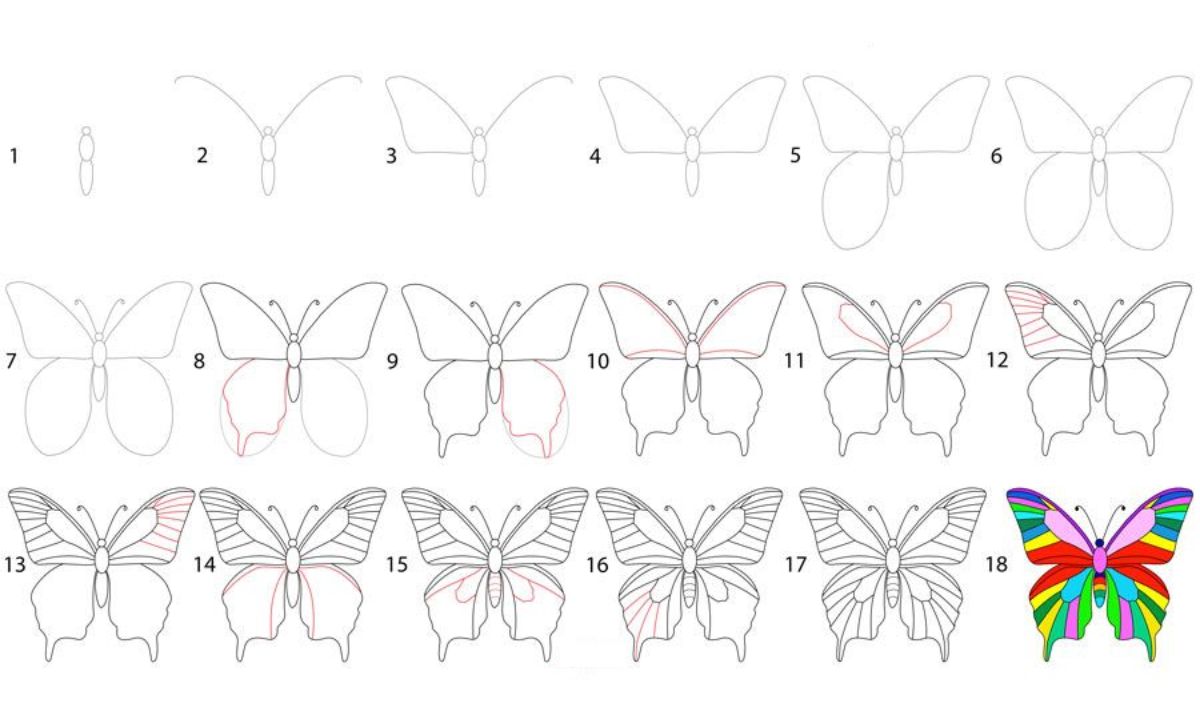Butterflies captivate our imagination with their delicate beauty and symbolic transformation. Whether you’re a seasoned artist or just starting your creative journey, butterfly drawings offer the perfect blend of simplicity and charm.
In this comprehensive guide, we’ll explore 23 cute and easy butterfly drawing ideas that will inspire you to pick up your pencil and start creating.
From basic outlines to imaginative compositions, these ideas cater to all skill levels and provide endless opportunities for artistic expression.
Butterflies make wonderful subjects for artwork because their natural symmetry provides built-in guidance for beginners.
These butterfly drawing ideas range from ultra-simple sketches to more elaborate scenes, allowing you to progress at your own pace. Each concept can be adapted to your skill level—simplify for quick doodles or add intricate details for more refined pieces.
“Butterflies are self-propelled flowers.” — Robert A. Heinlein
A Simple Butterfly
Let’s start with the most basic butterfly sketch that anyone can master. This fundamental design serves as the building block for more complex butterfly drawings.
The key to creating a simple butterfly drawing lies in symmetry. Start with a central body—a thin oval with a small circular head. Then add two matching wings on each side. For beginners, try drawing half of the butterfly first, then mirror it for the second half.
Step-by-step approach:
- Draw a straight vertical line as your symmetry guide
- Add an oval body along this line
- Draw a small circle for the head
- Sketch matching upper wings on both sides
- Add matching lower wings
- Erase your guide line
- Add simple antennae
- Include basic patterns on the wings if desired
For a truly basic version, stick with smooth-edged wings. As you gain confidence, experiment with more scalloped or detailed wing edges to capture the authentic butterfly look.
Butterfly From the Side
A butterfly from the side offers a fresh perspective and creates more dynamic artwork. This view captures the elegant profile of these insects and can convey a sense of movement that front-view drawings sometimes lack.
When creating a profile butterfly drawing, focus on showing the wings in alignment rather than spread out. One wing will be fully visible, while the second might be partially hidden or shown with a slight overlap. Pay attention to the body curve—butterflies have a slight arch to their bodies that’s more noticeable from this angle.
Tips for side-view success:
- Draw the body with a gentle curve
- Position antennae at a forward angle
- Show some texture on the visible wing
- Consider adding leg details for realism
- Experiment with different wing positions to show flying or resting
This perspective works beautifully for showing butterflies in flight or perched on flowers, creating more storytelling potential in your butterfly art.
Butterflies and Stars
Combining butterflies with celestial elements creates magical, dreamlike imagery. These aesthetic butterfly sketches tap into the whimsical qualities of both subjects and result in enchanting compositions.
Create a night sky backdrop using various sizes of simple star shapes. Position your butterflies flying among these stars, perhaps following a curved path to suggest movement. Consider adding stardust trails behind the butterflies or having stars incorporated into the wing patterns.
Color palette suggestions:
| Background | Butterflies | Stars | Accents |
| Deep blue | Silver/white | Gold | Purple |
| Black | Pastel colors | White | Blue sparkles |
| Purple | Gold | Silver | White highlights |
For added interest, try drawing some butterflies with translucent, star-speckled wings. This concept works particularly well for greeting cards, journal decorations, or children’s room art.
Butterfly and Flower
The classic pairing of a butterfly and flower creates an instantly recognizable and appealing image. This natural combination showcases the butterfly’s role as a pollinator and creates a harmonious composition.
When creating this traditional scene, consider the proportions carefully. A butterfly typically appears smaller than many flowers, so maintain this scale for realism. Position your butterfly either approaching the flower, resting on a petal, or hovering just above with its proboscis (feeding tube) extended toward the nectar.
Flower options that pair beautifully with butterflies:
- Daisies (simple for beginners)
- Sunflowers (bold focal point)
- Lavender (delicate and elegant)
- Hibiscus (tropical flair)
- Cherry blossoms (subtle and pretty)
For beginners, start with a simple flower like a daisy that has an uncomplicated structure. As your skills develop, try more complex flowers with multiple petals and layers.
Butterflies in a Flower Field
Expanding on the single flower concept, butterflies in a flower field creates a more immersive scene filled with life and movement. This composition allows you to practice drawing multiple butterflies and create depth in your artwork.
To create convincing depth, vary the size of both butterflies and flowers—larger in the foreground, smaller in the background. Position some butterflies flying above the flowers and others resting directly on blooms. For a cohesive look, maintain a consistent style across all elements rather than mixing realistic butterflies with cartoonish flowers.
Creating depth in your butterfly meadow:
- Draw larger, more detailed flowers and butterflies in the foreground
- Add medium-sized elements in the middle ground
- Include smaller, less detailed shapes in the background
- Overlap elements to create natural layering
- Consider adding light shading to enhance the dimensional effect
This field of butterfly art concept works beautifully for wall art, greeting cards, or as a calming meditation drawing exercise.
Girl Looking at Butterfly
Introducing human elements into your butterfly drawings adds narrative and emotional connection. A simple butterfly drawing paired with a girl creates an instant story about wonder, discovery, and the beauty of nature.
Keep the girl’s features relatively simple—focus on conveying her expression of delight or curiosity rather than creating a detailed portrait. Position the butterfly just beyond her reach or gently landing on her extended finger to create interaction between the characters.
Expression tips:
- Wide eyes to show wonder
- A slight smile to convey delight
- Raised eyebrows for surprise
- Parted lips for amazement
- A tilted head to suggest curiosity
For a cohesive style, match the level of detail in both the girl and the butterfly. If you draw a simplified, cartoon-style girl, pair her with a similarly styled butterfly rather than an anatomically precise one.
Hand and Butterfly
The image of a butterfly doodle perched on a human hand creates a powerful symbol of gentle connection with nature. This composition focuses on the contrast between the solid stability of the hand and the delicate, ephemeral quality of the butterfly.
Drawing hands can be challenging, so begin with a simple pose like an open palm or a single extended finger. Use basic shapes to block out the hand position before adding details. The butterfly can be shown just landing, resting, or about to take flight.
Hand pose options:
- Open palm with butterfly in center
- Single extended finger with butterfly perched on tip
- Loosely cupped hands as if gently holding the butterfly
- Hand reaching toward a nearby butterfly
- Two hands creating a protective space with butterfly inside
This concept works well in both color and black-and-white, with the latter emphasizing the shape contrast between hand and butterfly.
Cat and Butterfly
The playful interaction between a curious cat and fluttering butterfly creates an instantly engaging scene. This adorable butterfly doodle combination taps into the natural hunting instinct of cats while keeping the mood light and whimsical.
When creating your cat, focus on capturing an alert, interested expression—wide eyes, perked ears, and perhaps a slightly raised paw. Position the butterfly just out of reach to create tension in the scene. For a more humorous approach, draw the cat in an awkward position as it attempts to catch the elusive insect.
Cat expressions to consider:
- Wide-eyed fascination
- Head tilted in curiosity
- Crouched “hunting” position
- Mid-pounce action pose
- Surprised look as butterfly lands on nose
Keep the overall tone playful rather than predatory. This concept works exceptionally well for greeting cards, children’s illustrations, or social media art.
Butterfly and a Jar of Stars
This magical concept combines butterfly art with fantasy elements to create an enchanting, dreamlike scene. The transparent jar filled with glowing stars provides a luminous backdrop for your butterfly, creating a captivating visual.
When drawing the glass jar, focus on a few key lines to suggest its shape and transparency rather than attempting to draw every reflection. Add small stars inside in various sizes, with some emitting glow lines to suggest their light. Position your butterfly either inside the jar, perched on the rim, or flying nearby—each creates a different storytelling effect.
Creating magical light effects:
- Draw small dots of various sizes for stars
- Add short lines radiating from larger stars
- Use stippling (tiny dots) to create glow halos
- Leave white space around stars for brightness
- Add a few “escaped” stars floating outside the jar
This whimsical concept works beautifully for nursery art, fantasy illustrations, or dreamy journal decorations.
Butterfly Jar
Similar to the previous concept but with a different focus, the butterfly jar depicts butterflies captured or preserved in a glass container. This can be interpreted either literally as a scientific specimen collection or metaphorically as capturing the essence of beauty.
When creating this concept, pay attention to the arrangement of butterflies within the jar. They might be densely packed, showing various wing positions, or perhaps arranged in a spiral pattern ascending through the jar. Consider adding air holes in the lid or leafy elements at the bottom to suggest a habitat.
Jar variations to explore:
- Classic mason jar with metal lid
- Elegant apothecary jar with glass stopper
- Simple cylindrical container
- Vintage bell jar on a wooden base
- Miniature terrarium with plants and butterflies
For a more hopeful interpretation, show some butterflies emerging as the jar lid opens, symbolizing freedom and transformation.
Butterflies Around a Flower
This circular composition creates a visually satisfying pattern with butterflies and flowers at its center. The ring of butterflies draws the eye inward while creating a sense of movement and life around the central bloom.
When designing this layout, position your butterflies at regular intervals to create rhythm, but vary their wing positions and sizes to avoid monotony. The central flower serves as an anchor for the composition—choose something with a strong, recognizable silhouette like a rose, sunflower, or lotus.
Arrangement tips:
- Position butterflies in a complete circle or just a partial arc
- Vary distances from the center for more dynamic composition
- Alternate butterfly sizes or species for visual interest
- Consider having butterflies face both inward and outward
- Add small details like pollen particles or dewdrops for richness
This concept works beautifully as a mandala-like decorative piece, perfect for framing or as a striking journal cover design.
Two Butterflies
Sometimes simplicity creates the strongest impact. Drawing two butterflies together creates an immediate sense of relationship and can symbolize friendship, love, or familiar connection.
When composing this duo, consider their positioning carefully. They might be flying in parallel, facing each other, or perhaps one following the other. Their relationship becomes clearer through their positioning—butterflies facing each other suggest communication, while butterflies flying in the same direction imply companionship.
Positioning ideas:
- Flying side by side
- One slightly ahead of the other
- Facing each other as if communicating
- Wings touching briefly
- Circling each other in a dance-like pattern
To differentiate your pair, consider giving them slightly different wing patterns or colors while maintaining the same overall style and size.
Happy Cat and Butterfly
Building on the cat and butterfly concept, the happy cat and butterfly focuses specifically on creating a joyful, friendly interaction between these two creatures. Rather than depicting the cat as hunting the butterfly, this version shows a harmonious, playful relationship.
For the cat, emphasize an open, smiling expression with upturned mouth, relaxed whiskers, and gentle eyes. Position the butterfly in a non-threatened pose—perhaps landing on the cat’s nose or playfully fluttering just above its head. This creates a sweet subversion of what would naturally be a predator-prey relationship.
Creating a happy cat expression:
- Draw slightly closed, content-looking eyes
- Add an upturned mouth line
- Keep whiskers relaxed and slightly curved
- Position ears forward and relaxed
- Consider adding a small blush for extra cuteness
This concept works particularly well for children’s illustrations, greeting cards, or any project where a mood of friendliness and joy is desired.
Book Filled with Butterflies
This magical concept depicts butterflies emerging from an open book, symbolizing how reading brings imagination to life. These beautiful butterfly art pieces combine literary and natural elements for a powerful visual metaphor.
Start with an open book as your base—two rectangular pages with a curved center binding. Draw butterflies in various stages of emergence: some still flat on the page as illustrations, others partially lifting off, and still others fully formed and flying above the book. Consider adding text lines on the visible pages to enhance the book effect.
Creating the emergence effect:
- Draw butterflies that appear flat/2D on the page
- Show some with wings beginning to lift from the page
- Depict others halfway between page and air
- Include fully formed butterflies flying above
- Add motion lines or page-turning effects for dynamism
For enhanced magic, consider adding glowing particles, sparkles, or transforming text elements that morph into butterflies at the edges.
Line of Butterflies
A line of butterfly art creates a decorative border or pathway across your page. This versatile concept works beautifully for framing other artwork, as a stand-alone decorative element, or as a divider between sections of text.
When creating your butterfly line, establish a consistent baseline—either straight or gently curved—along which your butterflies will be arranged. Vary the wing positions and body angles slightly for natural variation while maintaining enough consistency to create a unified design.
Arrangement variations:
- Evenly spaced butterflies in a straight line
- Gradually increasing or decreasing butterfly sizes
- Alternating between two butterfly types or colors
- Creating a meandering path of butterflies
- Forming a circular wreath of butterflies
This concept adapts beautifully to different styles, from realistic to highly stylized, making it versatile for various projects and skill levels.
Butterflies and Flowers
This expanded concept creates a complete garden scene filled with various butterflies and flowers interacting in a natural environment. Unlike simpler butterfly-flower pairings, this composition creates a more immersive ecosystem with multiple elements.
Begin by establishing your ground line and planning the placement of your major flower elements. Add butterflies in various positions—some flying above, others resting on blooms, and perhaps a few just emerging from cocoons. Include additional garden elements like leaves, stems, and perhaps small insects for a complete scene.
Garden elements to consider including:
- Tall flowers (sunflowers, hollyhocks)
- Ground-level blooms (daisies, violets)
- Leafy plants without flowers
- Grasses or wheat stalks
- Small puddles reflecting butterflies above
This concept allows for storytelling and creates a complete environmental scene rather than isolated elements.
Simple Butterflies
For absolute beginners or those seeking quick butterfly doodles, these ultra-simplified designs reduce butterflies to their most basic elements while retaining their recognizable form.
The most basic butterfly can be created with just five lines: a central body line, two curved lines for upper wings, and two curved lines for lower wings. From this foundation, you can add minimal details like simple antennae or basic dot patterns while keeping the overall design clean and approachable.
Variations of simple butterflies:
- Circle body with triangle wings
- Figure-eight body with round wings
- Stick-figure butterfly with linear wings
- Heart-shaped wings with straight body
- “B” shaped butterfly (where the letter forms the body and wing outlines)
These simplified designs work perfectly for bullet journals, quick cards, or teaching children basic drawing skills.
Simple Cat and Butterfly
This concept combines two simplified elements—a basic cat and an easy butterfly—to create an accessible drawing for beginners or quick sketching.
For the simple cat, focus on the distinctive cat silhouette: pointed ears, round head, and curving body. Add minimal facial features—just eyes and perhaps a small nose. The butterfly can be equally basic with simple wing shapes. Position them in a clear relationship, such as the butterfly above the cat’s head or near a raised paw.
Simple cat features to include:
- Triangle ears
- Circular head
- Dot eyes
- Simple curved body
- Basic tail line
This concept proves that even with minimal details, you can create recognizable characters and suggest a narrative between them.
Little Boy and Butterfly
Similar to the girl with butterfly concept, this variation features a young boy interacting with a butterfly, offering different narrative possibilities and character designs.
When drawing your simple boy character, focus on creating a sense of childlike wonder and energy. Consider active poses like reaching, jumping, or running after the butterfly. For the most basic approach, use simple shapes—circle head, rectangle body, stick limbs—and add just enough details to convey expression and movement.
Boy pose ideas:
- Reaching up toward flying butterfly
- Crouched examining a butterfly on a leaf
- Running with net trying to catch butterfly
- Sitting quietly as butterfly lands on knee
- Pointing excitedly at distant butterfly
This concept works well for children’s illustrations, family-oriented cards, or playful decorative art.
Butterfly-Cat
This fantasy hybrid creates a whimsical creature combining features of both butterflies and cats. These imaginative butterfly illustrations allow for creative experimentation beyond realistic drawing.
Begin with a basic cat form—head, body, and limbs. Then add butterfly elements like wings emerging from the back, antennae sprouting from the head, or perhaps butterfly-patterned fur. The key is creating a balance between both creatures so that each remains recognizable in the hybrid form.
Ways to combine cat and butterfly:
- Cat body with butterfly wings
- Butterfly body with cat head and paws
- Cat with butterfly-patterned fur and small wings
- Butterfly with cat ears and tail
- Cat shape formed by arranged butterflies
This concept encourages imagination and works well for fantasy illustrations, character design practice, or whimsical artwork.
Butterfly Chibi Girl
This anime-inspired concept creates a cute humanoid character with butterfly elements in a chibi (small, childlike) style. These charming butterfly drawings combine human and insect features in an adorable package.
For the chibi style, exaggerate proportions with a large head (1/3 to 1/2 of total height) and small body. Add butterfly elements like small wings, antennae, or butterfly-themed clothing and accessories. Keep facial features simple but expressive, with large eyes being the dominant feature.
Butterfly elements to incorporate:
- Small wings on back
- Antennae headband or actual antennae
- Butterfly-patterned dress or clothing
- Butterfly hair clips or accessories
- Butterfly markings on face or body
This concept appeals particularly to anime and manga enthusiasts while still being accessible to beginners with its simplified style.
Flying Butterfly-Girl
This fantasy concept creates a fairy-like character with human features and large butterfly wings. Unlike the chibi version, this design uses more realistic proportions and larger wings for a more magical, ethereal quality.
Start with a basic human figure in a dynamic flying pose—arms extended, legs in motion. Then add large butterfly wings attached at the shoulder blades. The wings should be proportionately large enough to suggest they could actually lift the character. Consider adding other butterfly elements like antennae or patterned clothing to enhance the theme.
Flying pose suggestions:
- Arms extended forward in superhero-style flight
- One arm forward, one back for dynamic movement
- Legs in mid-run position for sense of taking off
- Graceful dance-like pose with gentle arm curves
- Looking back over shoulder while flying forward
This concept works beautifully for fantasy illustrations, character design, or magical-themed artwork.
Wrap up
Throughout this guide, we’ve explored 23 different butterfly drawing ideas ranging from ultra-simple designs to more complex scenes and fantasy concepts. Each idea offers a starting point that can be simplified for beginners or elaborated for more experienced artists.
The beauty of butterfly illustrations lies in their versatility and scalable complexity. Even the simplest butterfly doodle captures the essential magic of these creatures, while more detailed renditions can explore their intricate patterns and elegant forms.
Key takeaways from our butterfly drawing journey:
- Start with basic shapes and build complexity gradually
- Practice symmetry for traditional butterfly views
- Experiment with different perspectives and combinations
- Use butterflies as symbols of transformation and beauty
- Adapt any concept to your current skill level
Remember that the most important aspect of drawing is enjoyment. Whether you create a quick butterfly sketch or develop a complex scene, the process should bring you satisfaction and creative fulfillment.
Conclusion
Butterflies have inspired artists for centuries with their delicate beauty and profound symbolism of transformation. These 23 butterfly drawing ideas provide a roadmap for artists of all levels to capture their essence, whether through simple butterfly drawings or more elaborate compositions.
Don’t be afraid to combine elements from different ideas or to develop your own variations. Perhaps your butterfly might land on something unexpected, or you’ll discover a new way to incorporate these winged wonders into your artistic expression.
Which butterfly drawing will you try first? Whether you’re drawn to the simplicity of basic outlines or excited to create fantasy butterfly-human hybrids, there’s a butterfly waiting to take flight from your imagination onto paper. Grab your drawing tools and let your creativity soar along with these beautiful insects!
“Just like the butterfly, I’ve gone through a metamorphosis, been released from my dark cocoon, embraced my wings, and soared!” — Janine Canan










